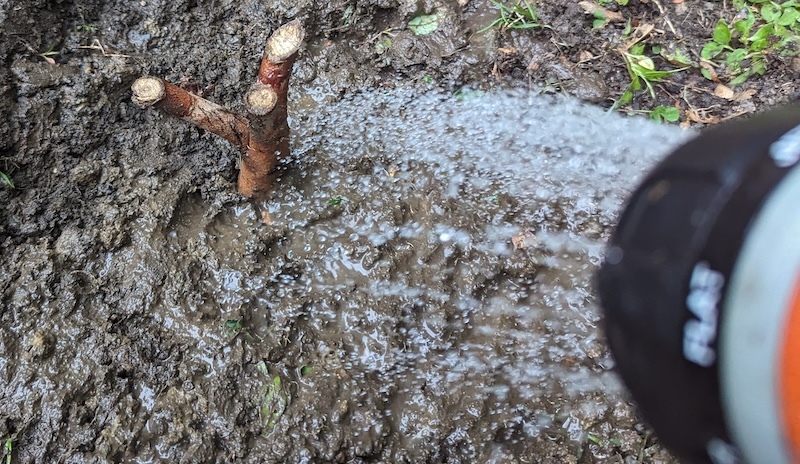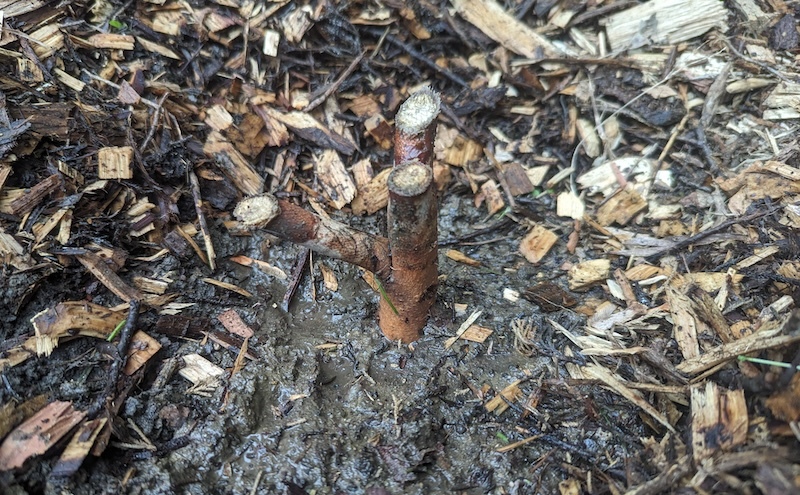Bare root plants are a great option to grow specialty plants at a fraction of the cost. “Bare root” means the plant does not grow in a pot with soil like most plants sold at nurseries. They are harvested from the grower’s bed in the fall, cleaned of soil, and stored dormant in a refrigerated space. When you receive the plant, don’t be alarmed by the scrawny appearance. Bare root plants are still dormant and will not have leaves or many branches yet.

There are many advantages of bare root plants, which we cover below. However, the trick to planting a bare root plant is to get it in the ground as soon as possible. If you are not able to plant it right away, keep the roots moist by adding a little water to the packaging. Store the plant in a cool, dark space like a basement or refrigerator.
How to Plant a Bare Root Plant
-
When your shipment arrives, carefully remove the bare root plant from the shipping box.
-
Unpackage the root ball and submerge it in a bucket of water for a few hours. Note: Avoid leaving the roots submerged for more than a day because prolonged soaking can lead to rot.
-
Locate the best position in your garden for the plant, considering factors such as sun exposure, mature size of the plant, soil composition, and moisture levels.
-
Dig a hole the same size as the root ball and loosen the soil around the edges to help the roots spread out.
-
Form a mound of loose soil in the center of the hole and spread the plant’s roots over it. Note: Do not leave the packaging around the roots when planting.
-
Position the root ball so the crown is even or slightly above the soil surface. If the plant has been grafted, make sure the graft union (bump near the base of the trunk) is above the soil line.
-
Backfill the hole with native soil. Do not add soil amendments, and avoid staking unless the tree is unstable.
-
Deeply water and soak the planting site to help remove any air pockets. If the soil has settled below the roots, add more soil to bring the level back up and water thoroughly.
-
Add a ring of organic mulch several inches thick around the root zone. Leave several inches of space between the mulch and the trunk.
Care After Planting
Continue to water your plant to keep the soil evenly moist for the next two weeks. These two weeks are the most important for helping your new plant establish, and the soil should never be allowed to dry out. Once the plant puts on new growth, you can ease back on watering. Provide a deep watering when the top 2 inches of soil are dry. Avoid fertilizing young trees and shrubs for the first year.

Benefits of Bare Root Plants
Bare roots plants have become a popular way to offer many trees, fruiting shrubs, roses, and deciduous shrubs to home gardeners. Planting trials have shown that these plants tend to adapt more quickly and establish in the new site. The reason is that the plant’s roots have never been confined by a container and the plant does not need to transition from potting soil to native ground soil.
Buying bare root plants has an economic advantage as well because they require less materials and labor to grow. The plants don’t take up as much space as a traditional potted nursery plant and require less plastic for potting and packaging. The cost of shipping a bare root plant is also lower because the plants weigh much less without soil. The grower can pass these savings onto the customer.
Disadvantages of Bare Root Plants
Bare root plants need to be planted immediately after arrival. The roots can dry out quickly, so the sooner you can get them in the ground, the better. Bare root plants are usually only available in the spring when the plants are still dormant and planting conditions are favorable. They can look unimpressive when they arrive, and may take 4-6 weeks after planting to wake up.
Despite these challenges, bare root is a fantastic option for growing new plants. Because they establish quickly, these plants are likely to live long, healthy lives in your garden. Take advantage of the savings and order one of these plants today!


